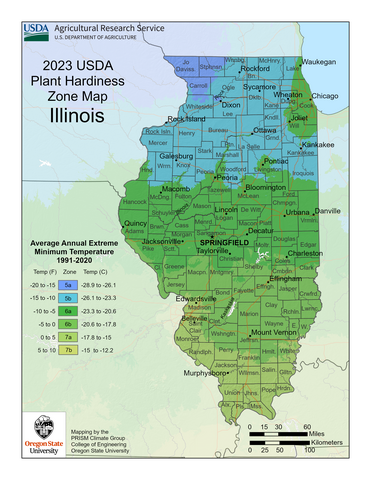
The USDA Plant Hardiness Zones have long been a standard in communicating plant suitability across the US. Everyone from gardeners and growers to scientists and crop insurance adjusters use these designations to make plant decisions every day. However, the geographic range of these zones is shifting as the effects of our changing climate are being realized.
New zones reflect new data
Back in November, the USDA released an updated map reflecting the addition of more recent weather data. The shift we see happening was a bit of a surprise, given the relatively short time frame it reflects.
“The magnitude of change in the new maps really surprised me since it just reflects the last 30 years,” says Illinois State Climatologist Dr. Trent Ford.
The updated maps were released on November 15 and are the first update since 2012. They represent data from 1991-2020 collected by 13,412 weather stations across the US. In contrast, the 2012 map was built from just 7,983 weather stations with a data set spanning 1976-2005. The larger number of stations included in the most recent map partly reflects the growth of private weather stations that can produce scientific quality weather information.
The Plant Hardiness Zones detailed in the new map define 13 distinct zones across the US and its territories. These zones are delineated based on the average annual lowest minimum temperature.
More simply put, the zones represent the lowest temperature each year, on average, for a geographic area. Zones are expressed as 10°F zones, noting an average extreme winter low within their specific 10°F range communicated by the zone number. The numerical zones are further divided into 5°F half zones indicated by letters “a” and “b.”
How has the map changed?
When looking at the new maps across the country, about half of the country shifted about a half zone warmer, whereas the other half of the country remained about the same in terms of zones. In the areas experiencing change, it reflects up to a 5°F shift toward warmer temperatures. However, USDA notes,” Some locations experienced warming in the range of 0-5 degrees Fahrenheit without moving to another half zone.” Keep in mind that each zone represents 10°F, so a 5°F shift to warmer temperatures may not necessarily drive a zone change for a given area.
“In Illinois, the most obvious change between the new hardiness zone map and the 2012 map is a northward progression of zones 6a-6b and 7a,” says Dr. Ford. “The boundary between zones 5b and 6a, representing an average annual extreme minimum temperature of -10°F, migrated 60 to 70 miles north, from around Springfield in the 2012 map to around Peoria in the 2023 map.”
On the 2012 map, central Illinois was bisected from north to south by the dividing line between zones 5b and 6a. On the new map, most of central Illinois now falls into zone 6a, with zone 6b moving north to occupy parts of Coles, Moultrie and Shelby Counties.
In a similar fashion, zone 7a has migrated north from Cairo (2012) to the St Louis Metro east area on the new map, representing a 40-50 mile northward migration. This has also pulled a small section of 7b up into Illinois. This is the first time it’s occurred this far north.
Much further north in the state, we can see an isolated and expanding area of zone 6a around the major population center in northeastern counties, from Lake Michigan westward.
Dr. Ford notes, "The 6a expansion in northeast Illinois is likely due to a combination of long-term winter warming and urban sprawl and development in the region.”
What can we expect now?
Gardeners use hardiness zones to determine how cold it may get in their area and to assess which plants may be able to tolerate the extreme low temperatures that can be expected. Plant hardiness zones are widely communicated and included in everything from plant tags in nurseries to guidebooks or online resources.
“One of the most consistent changes in Illinois’ climate that is directly linked to human-caused global warming is warming winters,” explains Dr. Ford. “In fact, climatological winter (December – February) average temperatures have increased faster than any other season over the past century.”
Warming winters can reduce stress on plant populations, helping some landscape plants thrive, but also bring negative impacts, such as expanding invasive species populations from the south, introducing new pest pressure on crops, or ecological competition in natural areas.
“The USDA hardiness zone maps represent average extreme low winter temperatures, but do not explicitly account for year-to-year variability, and the transition to a warmer winter climate in Illinois comes with large year-to-year variability,” notes Dr. Ford.
Most landscape plants are hardy across a range of zones, so interpretation of relative hardiness and vigor in your area can take some critical thinking. It’s safe to say that a plant known to be hardy from zones 4-8 will thrive in Zone 6, whereas a plant that is only hardy in Zone 6-8 may struggle if a winter extreme temperature tips below the expected average as a result of year to year variability.
Dr. Ford concludes, saying, “Overall, winter climate change in Illinois is messy and will continue to challenge farmers, gardeners, conservation professionals, and anyone else working hard to grow plants in the prairie state.”
What can you do?
If you are interested in helping to monitor the changing Illinois climate, there is a great opportunity to contribute right at home. Much of this data collection by private citizens that boosted the data behind this most recent USDA Plant Hardiness map was facilitated by the Community Collaborative Rain, Hail & Snow Network (CoCoRaHS). Participation in CoCoRaHS is needed around Illinois, and anyone can sign up and receive training on collecting and reporting weather data from home. The data you collect will be used for future updates of the USDA Plant Hardiness Zones and other important projects. For more information, visit the CoCoRaHS Website.
References
https://planthardiness.ars.usda.gov/
https://stateclimatologist.web.illinois.edu/2023/11/16/new-usda-plant-hardiness-zones-map/
